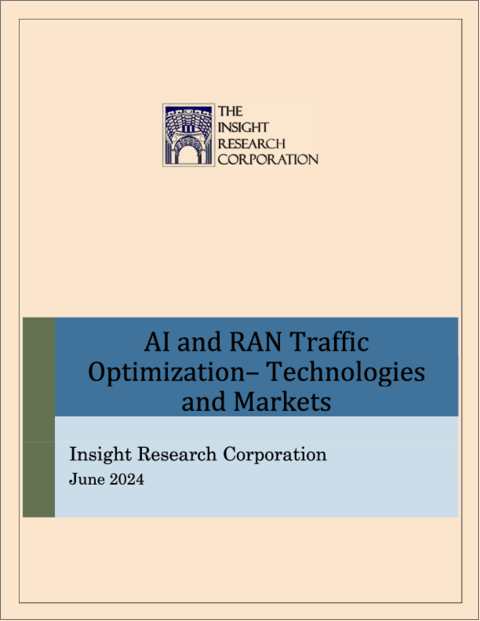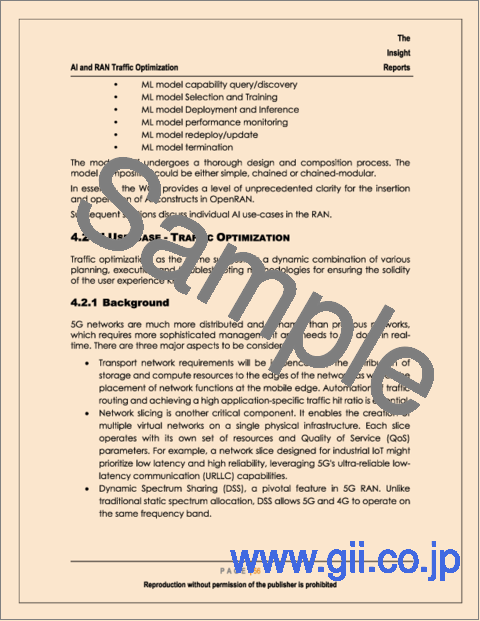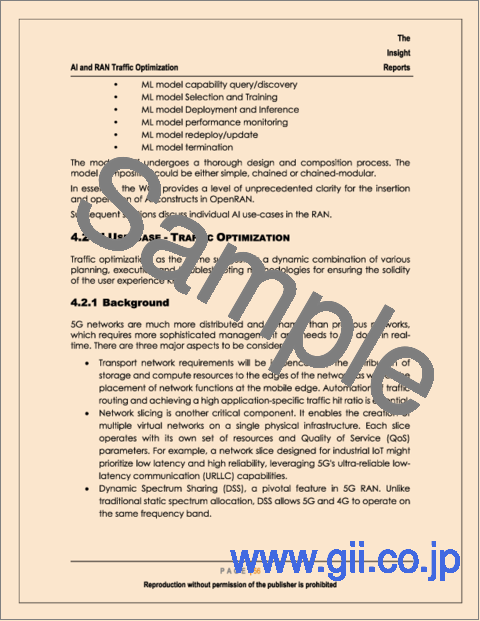|
|
市場調査レポート
商品コード
1499759
AIとRANトラフィック最適化 - 技術と市場AI and RAN Traffic Optimization - Technologies and Markets |
||||||
|
|||||||
| AIとRANトラフィック最適化 - 技術と市場 |
|
出版日: 2024年06月24日
発行: Insight Research Corporation
ページ情報: 英文 136 Pages
納期: 即日から翌営業日
|
全表示
- 概要
- 目次
AIはRANに決定的な進出を果たし、トラフィックの管理と最適化の方法を一変させました。何年も前から予測されていたことですが、AIは現在、RANに積極的に参入し、その構造と機能を再構築しています。
AIは、効率の向上、遅延の削減、ネットワークリソースの最適化により、RANトラフィック管理を強化しています。この変革は、RANが硬直したモノリシックな構造から、より細分化された俊敏でオープンなシステムへと移行することによって促進されます。Software-Defined Networking(SDN)、Network Functions Virtualization(NFV)、Cloud-Native Functions(CNF)、Open RAN(O-RAN)の役割は、RANトラフィックの最適化におけるAIの影響を可能にする上で重大です。これらの技術の進歩は、AIがRAN内のトラフィックを最適化するための基盤となり、ネットワークパフォーマンスの大幅な改善につながります。
当レポートでは、AIとRANトラフィック最適化について調査分析し、この変革の道のりを掘り下げ、トラフィック最適化に注目した重要な考察と市場予測を提供しています。
目次
第1章 エグゼクティブサマリー
- 主な見解
- 定量予測分類
- レポートの構成
第2章 AI/ML/DLの主な概念の説明
- AI
- 機械学習(ML)
- 教師あり機械学習
- 教師なし機械学習
- 強化機械学習
- K近傍法
- ディープラーニングニューラルネットワーク(DLNN)
- 注目すべきML/DLアルゴリズム
- 異常検知
- 人工ニューラルネットワーク(ANN)
- バッグドツリーズ
- CART、SVMアルゴリズム
- クラスタリング
- 条件付き変分オートエンコーダ
- CNN
- 相関とクラスタリング
- 進化的アルゴリズムと分散学習
- フィードフォワードニューラルネットワーク
- グラフニューラルネットワーク
- ハイブリッド認知エンジン(HCE)
- カルマンフィルター
- マルコフ決定過程
- 多層パーセプトロン
- ナイーブベイズ
- 放射基底関数
- ランダムフォレスト
- リカレントニューラルネットワーク
- 強化ニューラルネットワーク
- SOMアルゴリズム
- スパースベイジアン学習
第3章 RANの仮想化
- RANとその進化
- E-UTRANの詳細
- 5G-NR、NSA、SA
- MEC
- リジッドCPRI
- RANからvRANへの進化
- VMベース、コンテナベースvRANの比較
- NFVアーキテクチャ
- コンテナの必要性
- マイクロサービス
- コンテナの形態
- コンテナ展開方法
- ステートフルコンテナ、ステートレスコンテナ
- アドバンテージコンテナ
- コンテナが直面する課題
- RAN仮想化、アライアンスのストーリー
- O-RANアーキテクチャの概要
- O-RANの歴史
- O-RANのワークグループ
- オープンvRAN(O-vRAN)
- 通信インフラプロジェクト(TIP)OpenRAN
第4章 AIとRANトラフィックの最適化
- O-RANとAI
- イントロダクション
- RIC、xApps、rApps
- WG2とML
- AIユースケース - トラフィック最適化
- 背景
- 方法論と課題
- AIベースのアプローチ
第5章 RAN向けAIに関するベンダーの取り組み
- イントロダクション
- 注目すべき考察
- 企業と組織の概要
- Aira Channel Prediction xApp
- Aira Dynamic Radio Network Management rApp
- AirHop Auptim
- Aspire Anomaly Detection rApp
- Cisco Ultra Traffic Optimization
- Capgemini RIC
- Cohere MU-MIMO Scheduler
- DeepSig OmniSig
- Deepsig OmniPHY
- Ericsson Radio System
- Ericsson RIC
- Fujitsu Open RAN Compliant RUs
- HCL iDES rApp
- Huawei PowerStar
- Juniper RIC/Rakuten Symphony Symworld
- Mavenir mMIMO 64TRX
- Mavenir RIC
- Net AI xUPscaler Traffic Predictor xApp
- Nokia RAN Intelligent Controller
- Nokia AVA
- Nokia ReefShark Soc
- Nvidia AI-on-5G platform
- Opanga Networks
- P.I. Works Intelligent PCI Collision and Confusion Detection rApp
- Qualcomm RIC
- Qualcomm Cellwize CHIME
- Qualcomm Traffic Management Solutions
- Rimedo Policy-controlled Traffic Steering xApp
- Samsung Network Slice Manager
- ZTE PowerPilot
- VMware RIC
第6章 RAN向けAIに関する通信事業者の取り組み
- イントロダクション
- 注目すべき考察
- 企業と組織の概要
- AT&T Inc
- Axiata Group Berhad
- Bharti Airtel
- China Mobile
- China Telecom
- China Unicom
- CK Hutchison Holdings
- Deutsche Telekom
- Etisalat
- Globe Telecom Inc
- NTT DoCoMo
- MTN Group
- Ooredoo
- Orange
- PLDT Inc
- Rakuten Mobile
- Reliance Jio
- Saudi Telecom Company
- Singtel
- SK Telecom
- Softbank
- Telefonica
- Telenor
- Telkomsel
- T-Mobile US
- Verizon
- Viettel Group
- Vodafone
第7章 定量分析と予測
- 調査手法
- 定量予測
- 市場全体
- 携帯電話通信の世代
- 地理的地域
AI has made a decisive entry into the RAN, transforming how traffic is managed and optimized. After years of anticipation, AI is now actively present in RAN, reshaping its structure and capabilities. Our comprehensive new report, "AI and RAN Traffic Optimization- Technologies and Markets," delves into this transformative journey, offering key insights and market forecasts focused on traffic optimization.
AI is enhancing RAN traffic management by improving efficiency, reducing latency, and optimizing network resources. This transformation is facilitated by the transition of RAN from a rigid, monolithic structure to a more disaggregated, agile, and open system. The roles of Software-Defined Networking (SDN), Network Functions Virtualization (NFV), Cloud-Native Functions (CNF), and Open RAN (O-RAN) are crucial in enabling AI's impact on RAN traffic optimization. These technological advancements provide the foundation for AI to optimize traffic within RAN, leading to significant improvements in network performance.
Highlights:
- Insight Research breaks down the market for AI in RAN traffic optimization two criteria- mobility generation and geographical regions.
- Insight Research considers two mobility generations- 5G and others; and four geographical regions- NA, EMEA, APAC and CALA.
Table of Contents
1. Executive Summary
- 1.1. Key observations
- 1.2. Quantitative Forecast Taxonomy
- 1.3. Report Organization
2. AI/ML/DL Key Concepts Explainer
- 2.1. Artificial Intelligence
- 2.2. Machine Learning (ML)
- 2.2.1. Supervised Machine Learning
- 2.2.2. Unsupervised Machine Learning
- 2.2.3. Reinforced Machine Learning
- 2.2.4. K-Nearest Neighbor
- 2.3. Deep Learning Neural Network (DLNN)
- 2.4. Noteworthy ML and DL Algorithms
- 2.4.1. Anomaly Detection
- 2.4.2. Artificial Neural Networks (ANN)
- 2.4.3. Bagged Trees
- 2.4.4. CART and SVM Algorithms
- 2.4.5. Clustering
- 2.4.6. Conditional Variational Autoencoder
- 2.4.7. Convolutional Neural Network
- 2.4.8. Correlation and Clustering
- 2.4.9. Evolutionary Algorithms and Distributed Learning
- 2.4.10. Feed Forward Neural Network
- 2.4.11. Graph Neural Networks
- 2.4.12. Hybrid Cognitive Engine (HCE)
- 2.4.13. Kalman Filter
- 2.4.14. Markov Decision Processes
- 2.4.15. Multilayer Perceptron
- 2.4.16. Naive Bayes
- 2.4.17. Radial Basis Function
- 2.4.18. Random Forest
- 2.4.19. Recurrent Neural Network
- 2.4.20. Reinforced Neural Network
- 2.4.21. SOM Algorithm
- 2.4.22. Sparse Bayesian Learning
3. Virtualization of the RAN
- 3.1. The RAN and its Evolution
- 3.1.1. Closer Look at E-UTRAN
- 3.1.2. 5G- NR, NSA and SA
- 3.1.3. MEC
- 3.1.4. The Rigid CPRI
- 3.2. The Progression of the RAN to the vRAN
- 3.3. How VM-based and Container-based vRANs Compare?
- 3.3.1. NFV architecture
- 3.3.2. The Need for Containers
- 3.3.3. Microservices
- 3.3.4. Container Morphology
- 3.3.5. Container Deployment Methodologies
- 3.3.6. Stateful and Stateless Containers
- 3.3.7. Advantage Containers
- 3.3.8. Challenges Confronting Containers
- 3.4. RAN Virtualization A Story of Alliances
- 3.4.1. O-RAN Architecture Overview
- 3.4.2. History of O-RAN
- 3.4.3. Workgroups of O-RAN
- 3.4.4. Open vRAN (O-vRAN)
- 3.4.5. Telecom Infra Project (TIP) OpenRAN
4. AI and RAN Traffic Optimization
- 4.1. O-RAN and AI
- 4.1.1. Introduction
- 4.1.2. RIC, xApps and rApps
- 4.1.3. WG2 and ML
- 4.2. AI Use-Case - Traffic Optimization
- 4.2.1. Background
- 4.2.2. Methodologies and Challenges
- 4.2.3. AI-based Approaches
5. Vendor Initiatives for AI in the RAN
- 5.1. Introduction
- 5.2. Salient Observations
- 5.3. Company and Organization Summary
- 5.4. Aira Channel Prediction xApp
- 5.5. Aira Dynamic Radio Network Management rApp
- 5.6. AirHop Auptim
- 5.7. Aspire Anomaly Detection rApp
- 5.8. Cisco Ultra Traffic Optimization
- 5.9. Capgemini RIC
- 5.10. Cohere MU-MIMO Scheduler
- 5.11. DeepSig OmniSig
- 5.12. Deepsig OmniPHY
- 5.13. Ericsson Radio System
- 5.14. Ericsson RIC
- 5.15. Fujitsu Open RAN Compliant RUs
- 5.16. HCL iDES rApp
- 5.17. Huawei PowerStar
- 5.18. Juniper RIC/Rakuten Symphony Symworld
- 5.19. Mavenir mMIMO 64TRX
- 5.20. Mavenir RIC
- 5.21. Net AI xUPscaler Traffic Predictor xApp
- 5.22. Nokia RAN Intelligent Controller
- 5.23. Nokia AVA
- 5.24. Nokia ReefShark Soc
- 5.25. Nvidia AI-on-5G platform
- 5.26. Opanga Networks
- 5.27. P.I. Works Intelligent PCI Collision and Confusion Detection rApp
- 5.28. Qualcomm RIC
- 5.29. Qualcomm Cellwize CHIME
- 5.30. Qualcomm Traffic Management Solutions
- 5.31. Rimedo Policy-controlled Traffic Steering xApp
- 5.32. Samsung Network Slice Manager
- 5.33. ZTE PowerPilot
- 5.34. VMware RIC
6. Telco Initiatives for AI in the RAN
- 6.1. Introduction
- 6.2. Salient Observations
- 6.3. Company and Organization Summary
- 6.4. AT&T Inc
- 6.5. Axiata Group Berhad
- 6.6. Bharti Airtel
- 6.7. China Mobile
- 6.8. China Telecom
- 6.9. China Unicom
- 6.10. CK Hutchison Holdings
- 6.11. Deutsche Telekom
- 6.12. Etisalat
- 6.13. Globe Telecom Inc
- 6.14. NTT DoCoMo
- 6.15. MTN Group
- 6.16. Ooredoo
- 6.17. Orange
- 6.18. PLDT Inc
- 6.19. Rakuten Mobile
- 6.20. Reliance Jio
- 6.21. Saudi Telecom Company
- 6.22. Singtel
- 6.23. SK Telecom
- 6.24. Softbank
- 6.25. Telefonica
- 6.26. Telenor
- 6.27. Telkomsel
- 6.28. T-Mobile US
- 6.29. Verizon
- 6.30. Viettel Group
- 6.31. Vodafone
7. Quantitative Analysis and Forecasts
- 7.1. Research Methodology
- 7.2. Quantitative Forecasts
- 7.2.1. Overall Market
- 7.2.2. Mobile Telephony Generations
- 7.2.3. Geographical Regions
Tables and Figures
- Figure 3-1: VNF versus CNF Stacks
- Figure 3-2: O-RAN High-Level Architecture
- Figure 3-3: O-RAN High-Level Architecture
- Figure 3-4: Architecture of vRAN Base Station as Visualized by TIP
- Figure 4-1: Reinforcement learning model training and actor locations per O-RAN WG2
- Figure 4-2: AI/ML Workflow in the O-RAN RIC as proposed O-RAN WG2
- Figure 4-3: AI/ML deployment scenarios
- Table 5-1: AI in RAN Product and Solution Vendor Summary
- Figure 5-1: The Aira channel detection xApp functional blocks
- Figure 5-2: Modules of the Aspire Anomaly Detection rApp
- Figure 5-3: OmniPHY Module Drop in Typical vRAN Stack Overview
- Figure 5-4: Ericsson IAP
- Figure 5-5: HCL iDES rApp Architecture
- Figure 5-6: Working of the Net Ai xUPscaler
- Figure 5-7: Nokia RIC programmability via AI/ML and Customized Applications
- Figure 5-8: Timesharing the GPU in Nvidia Aerial A100
- Figure 5-8: Rimedo TS xApp in the O-RAN architecture
- Figure 5-9: Rimedo TS xApp in the VMware RIC
- Figure 5-10: PowerPilot Solution Evolution
- Table 6-1: AI in RAN Telco Profile Snapshot
- Table 7-1: Addressable Market in Traffic Optimization End-Application in Mobile RAN for AI and Related Technologies 2023-2028 ($ million)
- Table 7-2: Addressable Market in Traffic Optimization Application in Mobile RAN for AI and Related Technologies; by Mobile Telephony Generation 2023-2028 ($ million)
- Figure 7-1: Share of Addressable Market in Traffic Optimization End-Application in Mobile RAN for AI and Related Technologies; by Mobile Telephony Generation 2023-2028
- Table 7-3: Addressable Market in Traffic Optimization End-Application Mobile RAN for AI and Related Technologies; by Geographical Region 2023-2028 ($ million)
- Figure 7-2: Share of Addressable Market in Traffic Optimization End-Application Mobile RAN for AI and Related Technologies; by Geographical Region 2023-2028





